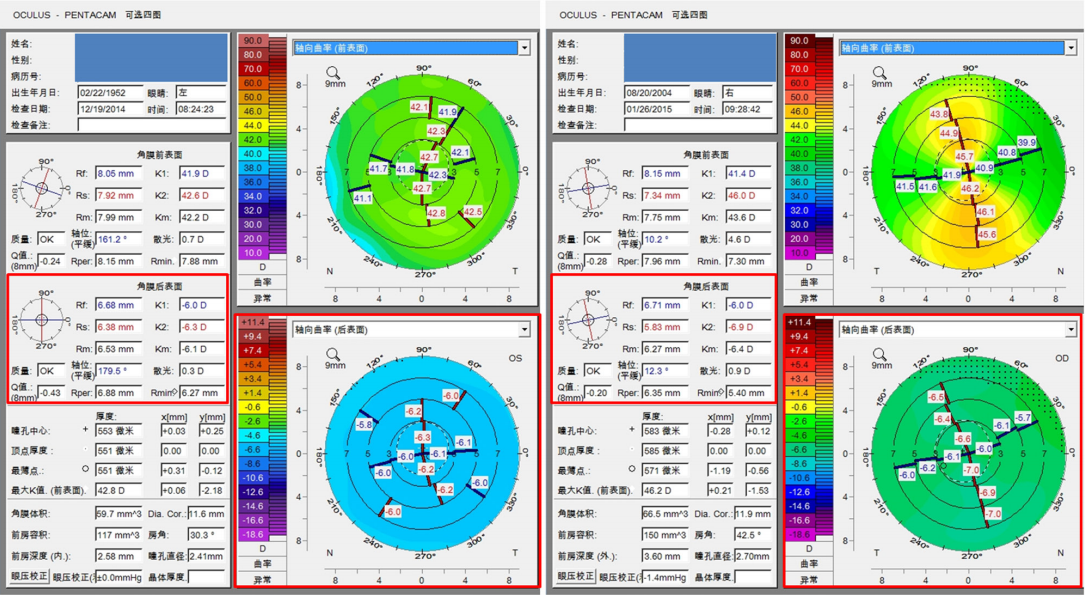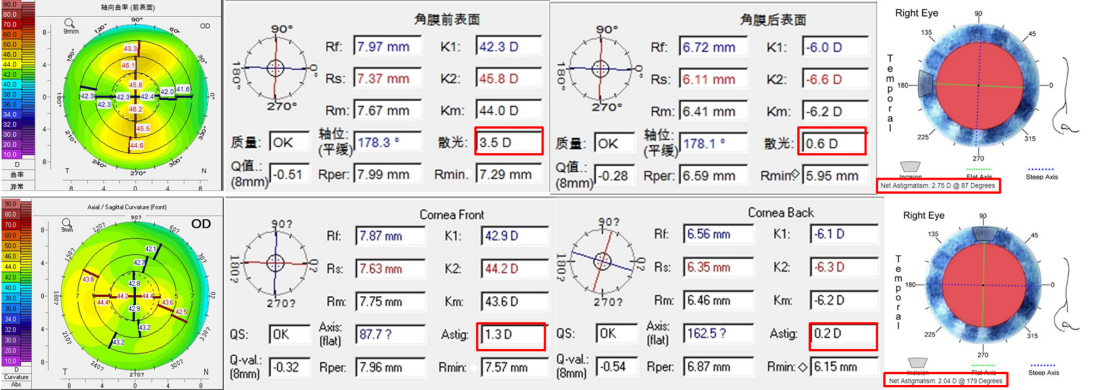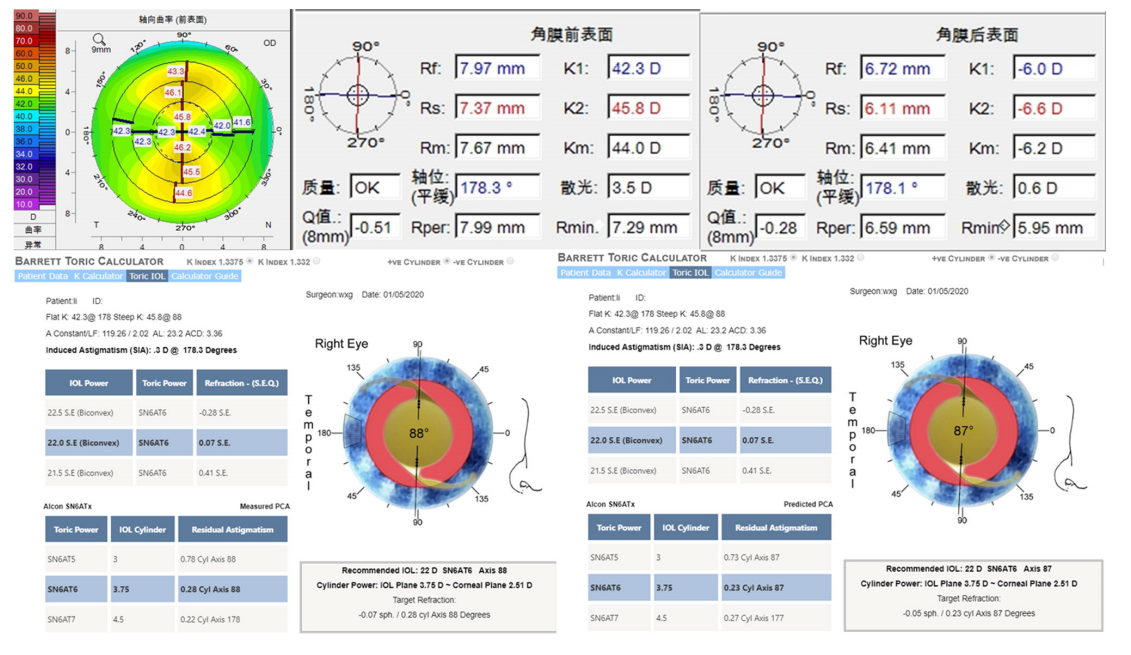1、Koch DD, Jenkins RB, Weikert MP, et al. Correcting astigmatism with
Toric intraocular lenses: effect of posterior corneal astigmatism[ J]. J
Cataract Refract Surg, 2013, 39(12): 1803-1809.Koch DD, Jenkins RB, Weikert MP, et al. Correcting astigmatism with
Toric intraocular lenses: effect of posterior corneal astigmatism[ J]. J
Cataract Refract Surg, 2013, 39(12): 1803-1809.
2、Warwick A, Porteous A, Saw VPJ. Visual and autorefraction outcomes
following Toric intraocular lens insertion without calculation of
posterior corneal astigmatism in the UK National Health Service[ J].
Eye (Lond), 2020, 34(11): 2082-2088.Warwick A, Porteous A, Saw VPJ. Visual and autorefraction outcomes
following Toric intraocular lens insertion without calculation of
posterior corneal astigmatism in the UK National Health Service[ J].
Eye (Lond), 2020, 34(11): 2082-2088.
3、Wang L, Mahmoud AM, Anderson BL, et al. Total corneal power
estimation: ray tracing method versus gaussian optics formula[ J].
Invest Ophthalmol Vis Sci, 2011, 52(3): 1716-1722.Wang L, Mahmoud AM, Anderson BL, et al. Total corneal power
estimation: ray tracing method versus gaussian optics formula[ J].
Invest Ophthalmol Vis Sci, 2011, 52(3): 1716-1722.
4、张蝶念, 张红, 田芳. 角膜后表面散光[ J]. 国际眼科纵览, 2015,
39(3): 170-174.
ZHANG DN, ZHANG H, TIAN F. Posterior corneal
astigmatism[ J]. International Review of Ophthalmology, 2015, 39(3):
170-174.张蝶念, 张红, 田芳. 角膜后表面散光[ J]. 国际眼科纵览, 2015,
39(3): 170-174.
ZHANG DN, ZHANG H, TIAN F. Posterior corneal
astigmatism[ J]. International Review of Ophthalmology, 2015, 39(3):
170-174.
5、Miyake T, Shimizu K, Kamiya K. Distribution of posterior corneal
astigmatism according to axis orientation of anterior corneal
astigmatism[ J]. PLoS One, 2015, 10(1): e0117194.Miyake T, Shimizu K, Kamiya K. Distribution of posterior corneal
astigmatism according to axis orientation of anterior corneal
astigmatism[ J]. PLoS One, 2015, 10(1): e0117194.
6、Ho JD, Tsai CY, Liou SW. Accuracy of corneal astigmatism estimation
by neglecting the posterior corneal surface measurement[ J]. Am J
Ophthalmol, 2009, 147(5): 788-795.Ho JD, Tsai CY, Liou SW. Accuracy of corneal astigmatism estimation
by neglecting the posterior corneal surface measurement[ J]. Am J
Ophthalmol, 2009, 147(5): 788-795.
7、Koch DD, Ali SF, Weikert MP, et al. Contribution of posterior corneal
astigmatism to total corneal astigmatism[ J]. J Cataract Refract Surg,
2012, 38(12): 2080-2087.Koch DD, Ali SF, Weikert MP, et al. Contribution of posterior corneal
astigmatism to total corneal astigmatism[ J]. J Cataract Refract Surg,
2012, 38(12): 2080-2087.
8、LaHood BR, Goggin M, Esterman A. Assessing the Likely Effect of
Posterior corneal curvature on toric IOL calculation for IOLs of 2. 50
D or greater cylinder power[ J]. J Refract Surg, 2017, 33(11): 730-734.LaHood BR, Goggin M, Esterman A. Assessing the Likely Effect of
Posterior corneal curvature on toric IOL calculation for IOLs of 2. 50
D or greater cylinder power[ J]. J Refract Surg, 2017, 33(11): 730-734.
9、Ueno Y, Hiraoka T, Miyazaki M, et al. Corneal thickness profile and
posterior corneal astigmatism in normal corneas[ J]. Ophthalmology,
2015, 122(6): 1072-1078.Ueno Y, Hiraoka T, Miyazaki M, et al. Corneal thickness profile and
posterior corneal astigmatism in normal corneas[ J]. Ophthalmology,
2015, 122(6): 1072-1078.
10、李盼盼, 吴坚, 周婧, 等. 角膜后表面散光的测量及临床意义[ J].
眼科新进展, 2018, 38(2): 184-187.
LI PP, WU J, ZHOU J, et al. Measurement and clinically
significant of posterior corneal astigmatism[ J]. Recent Advances in
Ophthalmology, 2018, 38(2): 184-187.李盼盼, 吴坚, 周婧, 等. 角膜后表面散光的测量及临床意义[ J].
眼科新进展, 2018, 38(2): 184-187.
LI PP, WU J, ZHOU J, et al. Measurement and clinically
significant of posterior corneal astigmatism[ J]. Recent Advances in
Ophthalmology, 2018, 38(2): 184-187.
11、Royston JM, Dunne MC, Barnes DA. Measurement of the posterior
corneal radius using slit lamp and Purkinje image techniques[ J].
Ophthalmic Physiol Opt, 1990, 10(4): 385-388.Royston JM, Dunne MC, Barnes DA. Measurement of the posterior
corneal radius using slit lamp and Purkinje image techniques[ J].
Ophthalmic Physiol Opt, 1990, 10(4): 385-388.
12、Kohnen T. Posterior corneal astigmatism[ J]. J Cataract Refract Surg,
2013. 39(12): 1795.Kohnen T. Posterior corneal astigmatism[ J]. J Cataract Refract Surg,
2013. 39(12): 1795.
13、Wang L, Cao D, Vilar C, et al. Posterior and total corneal astigmatism
measured with optical-coherence-tomography-based biometer and dual�Scheimpflug analyzer[J]. J Cataract Refract Surg, 2020, 46(12): 1652-1658.Wang L, Cao D, Vilar C, et al. Posterior and total corneal astigmatism
measured with optical-coherence-tomography-based biometer and dual�Scheimpflug analyzer[J]. J Cataract Refract Surg, 2020, 46(12): 1652-1658.
14、Reitblat O, Levy A, Kleinmann G, et al. Effect of posterior corneal
astigmatism on power calculation and alignment of Toric intraocular
lenses: comparison of methodologies[ J]. J Cataract Refract Surg, 2016,
42(2): 217-225.Reitblat O, Levy A, Kleinmann G, et al. Effect of posterior corneal
astigmatism on power calculation and alignment of Toric intraocular
lenses: comparison of methodologies[ J]. J Cataract Refract Surg, 2016,
42(2): 217-225.
15、Carey PJ, Leccisotti A, McGilligan VE, et al. Assessment of Toric
intraocular lens alignment by a refractive power/corneal analyzer
system and slitlamp observation[ J]. J Cataract Refract Surg, 2010,
36(2): 222-229.Carey PJ, Leccisotti A, McGilligan VE, et al. Assessment of Toric
intraocular lens alignment by a refractive power/corneal analyzer
system and slitlamp observation[ J]. J Cataract Refract Surg, 2010,
36(2): 222-229.
16、?zyol E, ?zyol P. Analyses of surgically induced astigmatism and axis
deviation in microcoaxial phacoemulsification[ J]. Int Ophthalmol,
2014, 34(3): 591-596.?zyol E, ?zyol P. Analyses of surgically induced astigmatism and axis
deviation in microcoaxial phacoemulsification[ J]. Int Ophthalmol,
2014, 34(3): 591-596.
17、Li X, Chen X, He S, et al. Effect of 1.8-mm steep-axis clear corneal
incision on the posterior corneal astigmatism in candidates for Toric
IOL implantation[ J]. BMC Ophthalmol, 2020, 20(1): 187.Li X, Chen X, He S, et al. Effect of 1.8-mm steep-axis clear corneal
incision on the posterior corneal astigmatism in candidates for Toric
IOL implantation[ J]. BMC Ophthalmol, 2020, 20(1): 187.
18、Kern C, Kortüm K, Müller M, et al. Comparison of two toric IOL
calculation methods[ J]. J Ophthalmol, 2018, 2018: 2840246.Kern C, Kortüm K, Müller M, et al. Comparison of two toric IOL
calculation methods[ J]. J Ophthalmol, 2018, 2018: 2840246.
19、Ribeiro FJ, Ferreira TB, Relha C, et al. Predictability of different calculators
in the minimization of postoperative astigmatism after implantation of a
Toric intraocular lens[J]. Clin Ophthalmol, 2019, 13: 1649-1656.Ribeiro FJ, Ferreira TB, Relha C, et al. Predictability of different calculators
in the minimization of postoperative astigmatism after implantation of a
Toric intraocular lens[J]. Clin Ophthalmol, 2019, 13: 1649-1656.
20、Jin YY, Zhou Z, Yuan XY, et al. Effect of the posterior corneal surface on
total corneal astigmatism in patients with age-related cataract[ J]. Int J
Ophthalmol, 2018, 11(6): 958-965.Jin YY, Zhou Z, Yuan XY, et al. Effect of the posterior corneal surface on
total corneal astigmatism in patients with age-related cataract[ J]. Int J
Ophthalmol, 2018, 11(6): 958-965.
21、Hatch KM, Woodcock EC, Talamo JH. Intraocular lens power selection
and positioning with and without intraoperative aberrometry[ J]. J
Refract Surg, 2015, 31(4): 237-242.Hatch KM, Woodcock EC, Talamo JH. Intraocular lens power selection
and positioning with and without intraoperative aberrometry[ J]. J
Refract Surg, 2015, 31(4): 237-242.
22、Woodcock MG, Lehmann R, Cionni RJ, et al. Intraoperative aberrometry
versus standard preoperative biometry and a Toric IOL calculator for
bilateral Toric IOL implantation with a femtosecond laser: One-month
results[ J]. J Cataract Refract Surg, 2016, 42(6): 817-825.Woodcock MG, Lehmann R, Cionni RJ, et al. Intraoperative aberrometry
versus standard preoperative biometry and a Toric IOL calculator for
bilateral Toric IOL implantation with a femtosecond laser: One-month
results[ J]. J Cataract Refract Surg, 2016, 42(6): 817-825.
23、Yesilirmak N, Palioura S, Culbertson W, et al. Intraoperative wavefront
aberrometry for toric intraocular lens placement in eyes with a history
of refractive surgery[ J]. J Refract Surg, 2016, 32(1): 69-70.Yesilirmak N, Palioura S, Culbertson W, et al. Intraoperative wavefront
aberrometry for toric intraocular lens placement in eyes with a history
of refractive surgery[ J]. J Refract Surg, 2016, 32(1): 69-70.
24、Lawless M, Jiang JY, Hodge C, et al. Total keratometry in intraocular
lens power calculations in eyes with previous laser refractive surgery[ J].
Clin Exp Ophthalmol, 2020, 48(6): 749-756.Lawless M, Jiang JY, Hodge C, et al. Total keratometry in intraocular
lens power calculations in eyes with previous laser refractive surgery[ J].
Clin Exp Ophthalmol, 2020, 48(6): 749-756.









